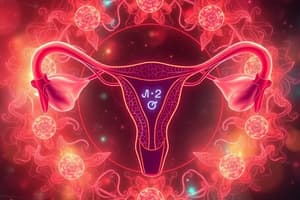Podcast
Questions and Answers
During which phase of the menstrual cycle does the shedding of the uterine lining occur?
During which phase of the menstrual cycle does the shedding of the uterine lining occur?
- Pre-ovulatory phase
- Luteal phase
- Post-ovulatory phase
- Follicular phase (correct)
Which hormone is responsible for thickening the uterine lining (endometrium) during the follicular phase?
Which hormone is responsible for thickening the uterine lining (endometrium) during the follicular phase?
- Testosterone
- Insulin
- Oestrogen (correct)
- Progesterone
What happens if fertilization does not occur after ovulation in the menstrual cycle?
What happens if fertilization does not occur after ovulation in the menstrual cycle?
- Oestrogen levels increase
- Corpus luteum produces more progesterone
- Corpus luteum degenerates (correct)
- Endometrium thins out
Which hormone maintains the uterine lining post-ovulation?
Which hormone maintains the uterine lining post-ovulation?
Which phase of the menstrual cycle involves a significant rise in progesterone levels?
Which phase of the menstrual cycle involves a significant rise in progesterone levels?
What marks the first day of menstruation in the menstrual cycle?
What marks the first day of menstruation in the menstrual cycle?
What is the role of the corpus luteum in the menstrual cycle?
What is the role of the corpus luteum in the menstrual cycle?
Which phase of the menstrual cycle is characterized by low progesterone levels?
Which phase of the menstrual cycle is characterized by low progesterone levels?
What happens to the corpus luteum if fertilization occurs after ovulation?
What happens to the corpus luteum if fertilization occurs after ovulation?
Which hormone is responsible for maintaining the thickness of the endometrium?
Which hormone is responsible for maintaining the thickness of the endometrium?
Study Notes
Understanding Reproduction: A Closer Look at the Menstrual Cycle
Reproduction is a fundamental biological process that allows species to perpetuate themselves through sexual reproduction. In mammals like humans, this process involves several complex steps, including the menstrual cycle, which plays a crucial role in preparing the female reproductive system for pregnancy.
The Menstrual Cycle Explained
The menstrual cycle can be divided into two main phases—the follicular phase and the luteal phase:
-
Follicular Phase (Days 1–14): This phase begins with the shedding of the uterine lining during menstruation and continues until ovulation occurs. During this time, the ovaries produce hormones that help prepare the reproductive tract for potential fertilization.
- Day 1 marks the first day of menstruation, when the uterus sheds its lining due to hormonal changes.
- Oestrogen levels increase, causing thickening of the uterine lining (endometrium) to support a possible embryo if fertilization occurs.
- Levels of progesterone remain low during most of the follicular phase.
-
Luteal Phase (Day 15–28): After ovulation, the corpus luteum produces progesterone to maintain the uterine lining. If fertilization does not occur within 24 hours after ovulation, the corpus luteum starts to degenerate, leading to the decline in progesterone production.
- Progesterone levels rise significantly post-ovulation, maintaining the endometrium's thickness for an implanting embryo.
- If fertilization does not happen, the corpus luteum breaks down, leading to decreased production of progesterone and subsequent menstruation.
In summary, the menstrual cycle involves the coordinated action of various hormones, such as oestrogen and progesterone, to ensure the health and preparation of the reproductive system for potential conception.
Studying That Suits You
Use AI to generate personalized quizzes and flashcards to suit your learning preferences.
Description
Explore the intricate process of the menstrual cycle in mammals, particularly in humans, through its two main phases—the follicular phase and the luteal phase. Learn about hormonal changes, the development of the uterine lining, and the role of progesterone and oestrogen in preparing the female reproductive system for potential pregnancy.




